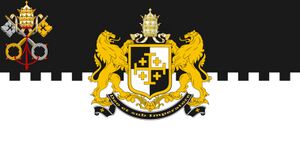Romerism: Difference between revisions
No edit summary |
No edit summary |
||
| Line 1: | Line 1: | ||
{{ModReview|Pricey|Plagiarism from {{wp|Falangism}}}} | |||
{{Infobox | {{Infobox | ||
| title = | | title = | ||
Revision as of 16:27, 21 January 2020
The reason given is:
Last edit by: Pricey (talk · contrib) · Last edited on Tue, 21 Jan 2020 16:27:38 +0000
| Romerism | |
|---|---|
 | |
| Information | |
| Core Tenets | Monarchism Conservatism Authoritarianism National Catholicism Anti-Communism Clerical Fascism Militarism |
| Topics | Creeperian Civil War |
| Organizations | Catholic Imperial Restoration Council Creeperian Initiative |
| People | Romero I Romero II Adolfo V Romero III Alfonso VI Alexander II |
| Part of a series on |
| Romerism |
|---|
 Cross of Creeperopolis (symbol of Romerism) |
|
Romerism (Creeperian Spanish: Romerismo) was the political ideology of the Catholic Imperial Restoration Council (also called the Romerists) during the Creeperian Civil War, and currently, of the Creeperian Initiative (officially: Nationalist Creeperian Catholic Royal Initiative and the Pro-Fatherland Front of Unification) as well as Initiative branches in El Salvador and the Papal State. Under the leadership of Romero I and Romero II, it largely became an authoritarian, Catholic, conservative ideology connected with Creeperopolis and its protectorates.

Romerism places a strong emphasis on Creeperian Catholic religious identity. Falangism emphasized the need for total authority, hierarchy, and order in society. Romerism strongly emphasizes anti-communism and pro-capitalism and is generally anti-democratic. Romerism promoted the revival of a Catholic Creeperopolis due to the ongoing civil war against the secular/atheist National Council for Peace and Order (also called the Miguelists).
Romerism has attacked the political left as its "enemy", especially the far-left. The Initiative declares itself Right-wing to Far-right, with many exiled Creeperian communists branding it as fascist.
